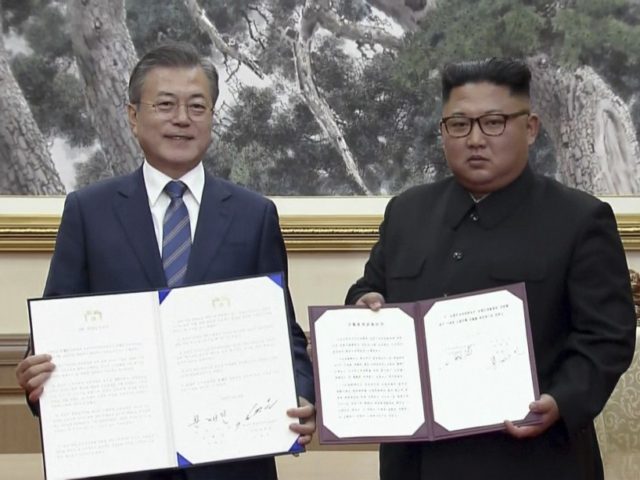North Korean dictator Kim Jong-un and South Korean counterpart Moon Jae-in signed an agreement Wednesday to “get rid of all threats in every part of the country that could spark war,” according to Moon, and potentially limit North Korea’s nuclear development in exchange for unspecified rewards.
South Korean officials claimed that Kim also agreed to potentially shut down its Yongbyon Nuclear Scientific Research Center in exchange for the United States “tak[ing] corresponding measures under the spirit of the June 12 North Korea-U.S. joint statement.” Neither side specified what corresponding measures Kim sought in exchange for shutting down Yongbyon, though they may likely involve getting Washington to support lifting international sanctions on the country. North Korea is currently under a severe UN-backed sanctions regime that prevents it from legally participating in most major international industries, though it benefits from illegal trafficking in its goods by Russia and China.
President Donald Trump responded positively to the developments in Pyongyang, where Moon is making an official visit, calling the agreements the two leaders came to “very exciting!”
In South Korea, conservatives growing increasingly irate at the millions of dollars the Moon administration is spending on the communist rogue regime in Pyongyang appeared less impressed with the high-level summit this week.
In a piece titled “Moon, Kim Announce Little of Substance After Summit,” the right-leaning South Korean newspaper Chosun Ilbo lamented that most agreements the two leaders supported were heavily caveated or involved topics outside of the realm of security, like agreeing to make a joint bid to host the Olympic Games. Other concrete agreements from the summit include a commitment by Kim to visit Seoul this year – the first such visit by a North Korean dictator to its free neighbor – and a pact to “expand cooperation in various fields such as resuming tours to Mt. Kumgang and reopening the Kaesong Industrial Complex once circumstances permit, and reopening a facility at the scenic resort.”
Kim has reportedly heavily prioritized the development of a tourist industry in North Korea. In addition to convincing Moon to support the resumption of tours to Mt. Kumgang, Kim reportedly pitched Washington to help it develop a “world-class resort” in Wonsan, a beachside town, and appeared to successfully convince China to promote the venue.
Following his meeting with Kim, Moon told reporters that the two “discussed denuclearization steps for the first time.” According to Moon, North Korea “agreed to permanently shut down its Dongchang-ri missile engine testing facility and missile launch pad under the participation of experts from related countries.” The text of the agreement Moon and Kim signed read:
The North expressed its willingness to continue taking additional steps, such as the permanent shutdown of the Yongbyon nuclear facility, should the United States take corresponding measures under the spirit of the June 12 North Korea-U.S. joint statement.
The Yongbyon nuclear facility is an experimental site believed to feature reactors and uranium enrichment technology. Unlike the Punggye-ri Nuclear Test Site, which Kim claimed to have blown up in May, Yongbyon has never been a test site, rather the place where the regime develops fissile material. Yongbyon reportedly continues active. Satellite images taken in June showed “improvements to the infrastructure” at the site “at a rapid pace,” according to the monitor site 38 North.
The June 12 statement, known alternatively as the Singapore Declaration, requires the United States to “commit to establish new U.S. – DPRK relations in accordance with the desire of the population of the peoples of the two countries for peace and prosperity” and “join … efforts to build a lasting and stable peace regime on the Korean Peninsula.” Moon did not specify what moves Kim considers acceptable as “corresponding measures” in terms of these commitments.
Chung Eui-yong, Moon’s national security adviser, also told reporters that Kim further agreed “to terminate the Tongchang-ri missile engine testing site and a launch pad there and allow an inspection by international experts, including those from the U.S.” Neither Kim himself nor North Korean state media has confirmed this claim.
Moon is scheduled to travel to the United States next week to brief President Trump personally on the developments in Pyongyang. On Twitter, Trump responded to the developments Wednesday positively, focusing first on the fact that Seoul officials claimed Kim agreed to “nuclear inspections.” Tongchang-ri is a missile test site, however, not necessarily a facility that houses nuclear assets. Chung’s statement did not mention Yongbyon, Punggye-ri, or any other known nuclear facility.
Kim Jong Un has agreed to allow Nuclear inspections, subject to final negotiations, and to permanently dismantle a test site and launch pad in the presence of international experts. In the meantime there will be no Rocket or Nuclear testing. Hero remains to continue being……..
— Donald J. Trump (@realDonaldTrump) September 19, 2018
….returned home to the United States. Also, North and South Korea will file a joint bid to host the 2032 Olympics. Very exciting!
— Donald J. Trump (@realDonaldTrump) September 19, 2018

COMMENTS
Please let us know if you're having issues with commenting.